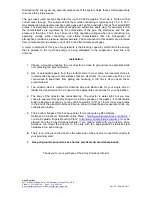
Array Solutions
2611 N. Belt Line Road, Suite 109, Sunnyvale, Texas, 75182, USA
Phone: +1 214-954-7140 - Fax: +1 214-954-7142
www.arraysolutions.com
– e-Mail:
Rev. 2.3
– Sept. 29, 2017
Dissipating the energy among several components of the system helps these small suppressors
to survive fairly large surges.
The gas tubes used are typically rated for up to 20,000 amperes. Their life is limited at that
current level, though. The voltage across them while conducting is typically only 15 V to 20 V.
Gas discharge tubes operate just like spark gaps and can fire hundreds of times from small EMP
pulses. The advantage over a simple spark gap (an automotive spark plug, for example) is that
the characteristics are regulated by the composition of the gas, the electrodes and the gas
pressure in the tube. Thus, they can survive high operating voltages when not conducting, low
operating voltage while conducting, and stable characteristics that are independent of
atmospheric conditions, pressure and temperature. The components in this arrestor are protected
from contaminants and oxidation, all of which can affect simple spark gaps.
A major component of this type of suppressors is the blocking capacitor, which limits the energy
that is passed to the rig while energy is being dissipated in the suppressor, feed line, and
antenna.
Installation:
1. Choose a mounting location for your arrestor as close to ground level as practical while
not contacting the ground directly.
2. Use of anti-oxidant paste from the electrical aisle in most home improvement stores is
recommended between metal surfaces that are dissimilar. You can also use this on all
connections to keep them from galling and oxidizing. A thin film is all you need. Get a
small container.
3. The arrestor label is marked for Antenna side and Radio side for your single wire or
ladder line transmission line. Connect to the appropriate connections for your installation.
4. The body of the arrestor has removable top. The arrestor is water tight, but you may
chose to augment this by smearing some silicone grease on the gasket. If condensation
build up becomes an issue, you may drill a few small
(1/16” or 1.6 mm max.) weep holes
in the end of the arrestor that faces down to allow it to breathe and evaporate / drain any
condensation inside.
5. The 4 bottom flanges of the box have holes for mounting using #8 hardware.
Optional: An aluminum
“Balun Mounting Plate” (
http://www.arraysolutions.com/bmp-4
)
or a D
elrin plastic “Dipole Mounting Plate” (
http://www.arraysolutions.com/dmp
) may be
ordered from the Array Solutions website. If you order a plate with your arrestor, Array
Solutions will mount the arrestor to the plate with the appropriate #8 stainless steel
hardware at no extra charge.
6.
There is an 8-32 ground terminal on the radio side of the arrestor. Connect this directly to
your ground system.
7. Keep all ground connections as short as practical and avoid sharp bends.
Thank you for your purchase of the Array Solutions Arrestor













